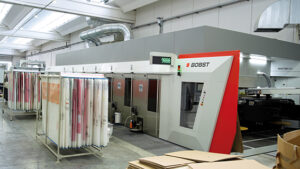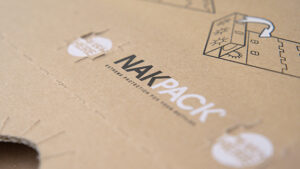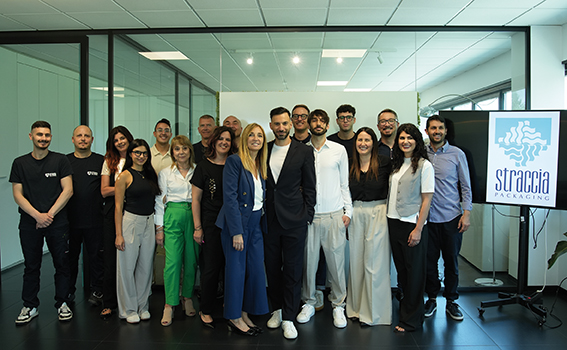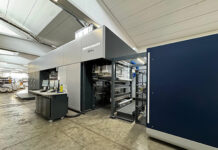Straccia Packaging is a benchmark in central and southern Italy, boasting a cutting-edge machinery fleet and an increasing focus on innovation and sustainability. We discuss this in the following article with Pietro Straccia, the young and passionate owner of the company, and in the video where we delve into the details of the new BOBST MASTERDRO 1628 machine
Founded in 1948 by Pietro Straccia in the area of San Benedetto del Tronto (AP), considered Italy’s leading fishing port, Straccia Packaging began as a producer of wooden cases for fish transport. A craft-based business rooted in the local territory, the company has successfully evolved over time, undergoing various stages of development and expansion, and has become a key player in the packaging sector.
The first major turning point came with the second generation, when Daniele Straccia, son of founder Pietro, recognized the potential of cardboard as a packaging material. This marked the beginning of a new era, with the production of the first cardboard boxes designed for the fishing sector, especially for ocean-going vessels and fishing boats equipped with onboard freezing systems, as well as for the flourishing local furniture industry, which needed large packaging solutions for transport and product protection.

In the 1990s, the company relocated from Acquaviva Picena to Colonnella (TE), where in 1998 it inaugurated a new 10,000 sm facility. The following year marked another milestone: the arrival of the first high-definition BOBST 6-color flexo printing machine, one of the first two installed in Italy. This pivotal step propelled Straccia Packaging into the world of high-quality printing, establishing it as a reference point for the central and southern Italian market.
Expansion did not stop there. In 2014, the facility doubled in size, reaching 20,000 sm, and the machinery lineup expanded with new printing and processing lines. Today, the company boasts 7 high-performance lines: a BOBST FFG 618 casemaker with 4 colors, a BOBST FFG 924 casemaker with 6 fixed-color units, a MASTERDRO 1628 rotary die-cutter with 6 colors, plus two 4.80-meter casemakers (one with a double stitching head), a BOBST SPO for flatbed die-cutting, a digital die-cutting plotter, and a new Eterna EFOLD 1700 folder-gluer with dual feeder and bundle collector, also from the BOBST Group.
Today, in addition to a complete and high-performing machinery park, Straccia Packaging has reached a covered area of over 50,000 sm and employs 60 people, serving the food, frozen goods, furniture, industrial, and mechanical sectors.

BOBST MASTERDRO 1628 6-Color: the latest addition raising the bar for competitiveness
The newest addition to the company is the MASTERDRO 1628, marking a strategic turning point. “With this machine, we’ve surpassed previous limits in terms of size, performance, and speed”, says Pietro Straccia, son of Daniele and CEO of the family business. “It has allowed us not only to optimize our existing jobs, but also to enter new markets, such as high-end displays, wrap-around boxes, and generally large-volume die-cut packaging, all while maintaining a high standard of quality”.
This machine has also brought rotary die-cutting closer to the precision of flatbed die-cutting, enabling a significant boost in production efficiency, as the rotary converting process completes the packaging in one single pass.

Technological innovation goes hand in hand with product innovation
But innovation at Straccia packaging doesn’t stop at technology. “For us, innovating also means developing new products”, Pietro continues, “a prime example is Nakpack, a patented system for wine e-commerce”.
Originally born almost as a game, in collaboration with Angelo Badinu and with a focus on sustainability and circular economy, Nakpack is a specially designed die-cut solution that suspends the bottle inside the box, preventing breakage in 99.5% of cases, a certified feature. It offers a green alternative to polystyrene. Following its success in Italy and France, it is now entering the U.S. market. The company is currently updating the patent to make it fully automatable, thanks to a new folder-gluer that will produce packaging fully assembled and ready for use.
Another key factor is the ability to respond quickly to market demands. “We’ve almost become an emergency room for our clients”, Pietro says with a touch of irony. “Scheduling is a thing of the past, the world is changing, and everything is urgent”. To tackle this challenge, the company has strengthened its technical department, now consisting of three people, including one who previously worked for a printing plate supplier. “Thanks to our in-house software, including 3D implementation and autonomous graphic management, we are faster and reduce costs. We only outsource the engraving of flexo photopolymer plates”.
In order to further enhance efficiency and customer service, a new logistics and handling system for semi-finished and finished products will be launched in the production departments next September. The project, entrusted to Emmepi Group, along with the upgrade of various production lines, will involve an investment of approximately €10 million by Straccia Packaging.

Straccia Packaging and its commitment to sustainability
Alongside production efficiency, the company is increasingly focused on sustainability. With 5 MW solar panels, the plant is now nearly energy self-sufficient. The company holds ISO 9001, 14001, 18001, 45001, FSC, and EMAS certifications, and is currently working on its sustainability report and on obtaining gender equality certification.
This commitment is further supported by a comprehensive corporate welfare plan, which includes free medical care for employees and their families, annual bonuses, and ongoing training programs. “In September, we will also launch an efficiency improvement initiative with Induvation, a German firm that has already collaborated with leading players in the corrugated cardboard sector”, adds Pietro Straccia.
A call to government to keep businesses competitive
From a market standpoint, the context remains challenging. “Our sector is in recession, volumes are down, and uncertainty weighs heavily. We managed to close the first four months of the year in line with last year, even though we were below budget, but purchasing power is declining, and businesses are struggling”, says Pietro.
“We need bold action from the government to keep businesses competitive and to simplify bureaucracy. We also need to restore purchasing power to our workers by reducing the tax burden on labor in their favor. Europe has enormous potential: if internal demand grows, the industry will grow too”.
Straccia Packaging is a clear example of how a company deeply rooted in its territory can evolve, tackle market challenges, and continuously innovate, without ever losing sight of its people. With major investments in technology, sustainability, and human capital, the company looks to the future with the confidence of those who have a strong legacy and a clear identity to carry forward.























